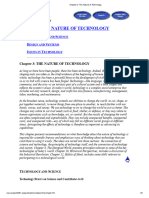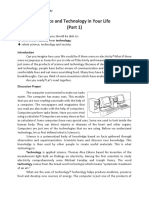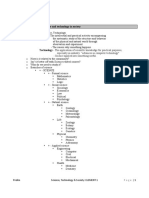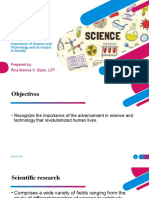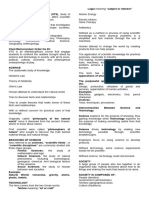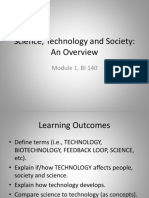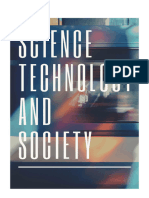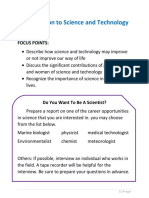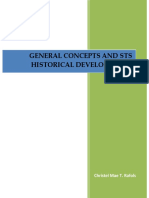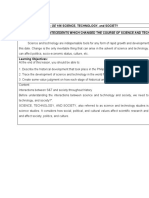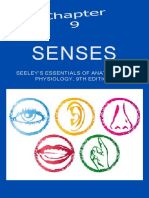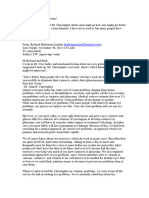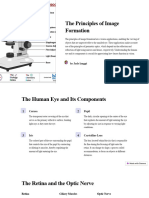STANDARD 7 Science Notes-Converted-1
Uploaded by
acookieboy15STANDARD 7 Science Notes-Converted-1
Uploaded by
acookieboy15STANDARD 7
THE NATURE OF SCIENCE
• Science is the study of everything around us.
• It can also be described as a process by which we study or gain knowledge of
our surrounding.
• Science is defined as knowledge gained through observing, asking questions
and carrying out experiments to find out answers.
WHAT IS SCIENTIFIC THINKING?
The steps followed by scientists in order to carry out information about a certain
problem.
Scientists are ordinary people like us but they look at things and think about them in a
scientific way.
STEPS IN SCIENTIFIC THINKING
The process of doing science follows certain steps called scientific process.
i. OBSERVATION
Scientists observe things by using senses
• Seeing
• Feeling
• Tasting
• Hearing
• Smelling
ii. RECORDING
Scientific observation must be described and measured if possible. Then it must
be recorded down so that there can be no mistakes later.
iii. QUESTIONING
Scientists always ask questions about their observation.
• Why?
IDEAL TUTORIAL SERVICES MR T. ISAAC 71513601 or 72651134 Page 1
• How?
• What?
iv. HYPOTHESIS
Once the questions have been asked, the scientist must think of possible answers
or explanations. This possible answer is called hypothesis. It is a possible
answer because it has not yet been tested.
v. EXPERIMENTING OR INVESTIGATION
The scientist has to think and decide of the investigation can do or what
experiment can perform to prove that the hypothesis is correct or not.
vi. CONCLUSION
Once the scientist has investigated or experimented and decides that the
hypothesis is correct or not, they must now describe the result or conclusion.
vii. COMMUNICATION
When the scientist has made a discovery that has been approved, they tell other
scientists what they found or discovered. This is called communication and it is
done by writing an article in a scientific magazine or writing letters to other
scientists.
DIFFERENCE BETWEEN QUESTION AND HYPOTHESIS
A question and hypothesis are two different things.
A question is something you ask yourself such as why? How? When? What if?
Scientific questions are measurable or very clear and specific. These questions
can only be proved through a scientific investigation.
A hypothesis is a possible answer or explanation for the question. It is not a
complete answer because it must first be tested or confirmed.
HOW SCIENTISTS GENERATE NEW IDEAS
Scientists generate new ideas through research. There are two main kinds of
research; pure research and directed research.
IDEAL TUTORIAL SERVICES MR T. ISAAC 71513601 or 72651134 Page 2
a) Pure Research
A scientist who does pure research is trying to find out more about
anything general that interests them. They do not study a specific
problem.
b) Directed Research
In directed research also called practical research the scientist studies
and investigates a particular problem to try to find an answer.
Example
A scientist may decide to try to find the cure for AIDS. Then they will
study the virus that causes AIDs and try different ways or methods to
fight it.
TECHNOLOGY IN SCIENCE
WHAT IS TECHNOLOGY?
Technology is the use of our knowledge, skills, and information gained from science to
make items that make our lives easier.
It can also simply be defined as, the application of scientific knowledge and discoveries.
For instance, it uses scientific knowledge to design and make somethings that we can
use to solve a problem or meet our needs.
NATURAL AND MAN MADE OBJECTS AND MATERIALS
Natural objects and materials are those that are found in nature.
Man-made or artificial objects and materials are created or manufactured by man.
Men made things are made from natural materials.
Natural Materials
• Air
• Rocks and ore
• Plants
• Water
IDEAL TUTORIAL SERVICES MR T. ISAAC 71513601 or 72651134 Page 3
• Coal
• Soil
• Minerals
Man Made Materials
• Iron and steel made from ores in rocks
• Glass made from sand
• Gas from coal and oil
• Explosives from minerals such as sulphur
• Chemicals such as herbicides and pesticides
• Rubber made from the sap of trees
• Medicines made from minerals and plant material
TECHNOLOGY IN OUR LIVES
Technology has changed our lives in many ways and we now find it very difficult to
live without the benefits it brings. Without technology there would be ;
• No electricity
• No cars, trucks and trains
• No radio, CD players and television
• No telephones
• No clocks or watches
• No farm machinery
• No vaccines
• No computers
• No cameras
Without technology our lives would be very difficult and much harder.
USING TECHNOLOGY
Every technological instrument should be used correctly.
IDEAL TUTORIAL SERVICES MR T. ISAAC 71513601 or 72651134 Page 4
The Watch
Many years ago people used hour glasses to measure time.
Later they used clocks with weights and large gears.
Through the use of technology we are now able to use analogue and digital
watches.
• All watches and cloaks must be handled carefully
• If they are dropped they can break very easily
• If any water gets into them, they will stop working
The Telephone
Telephone was inverted nearly 200 years ago by Alexander Graham Bell.
The old types of telephones were large and clumsy and had dials which were
turned to ‘dial’ a number compared to the modern telephones which are smaller
and use push-buttons to dial the number one wants to call.
The Camera
The Camera was invented in 200 years ago.
Older cameras were to be adjusted for bright or dim light and for distance, but
modern ones are able to make these adjustments automatically. You just have to
look through the viewfinder and then press the shutter button.
The Calculator
In the past all calculations were done by hand but later, calculators were
invented which used gears. Modern calculators use transistors and are electronic
calculators.
THE IMPACT OF TECHNOLOGY
i. On Agriculture
Before technology people used simple hand tools to dig, plough and harvest. This
meant that farmers could not plant large lands or produce much food.
With technology we now have;
IDEAL TUTORIAL SERVICES MR T. ISAAC 71513601 or 72651134 Page 5
• Tractors, planters, plough, harvesters, cultivated
• Fertilisers
• Herbicides
• Large graders to make to clear the lands
ii. On Medicine
Technology has provided ways of helping doctors to see what is happening
inside a patient's body.
• X-ray machines can take pictures that show bones right through the flesh
• Ultrasound machines used to show a baby inside the mother's uterus. The
doctor can see if the baby is growing well and if everything is correct.
• Science and technology have also helped in the development of antibiotics
and other medicines which can cure diseases which killed thousands
people in the past
• Technology also helps doctors to carry out operations that can correct
many physical problems which people have.
iii. On Space Science
Space Science studies the space around the earth, the moon and the planet in the
solar system.
In the past, scientists could only study the moon and other planets by looking
through telescopes. Through the use of new technology, rockets have been
developed which can travel into space and look at our earth and solar system in
much more detail than ever before.
TECHNOLOGY CAN SOLVE PROBLEMS
Technology has given us machines, tools and chemicals to solve many problems.
Here are few examples;
• Telephones help us to communicate directly instead of having to send a
messenger.
IDEAL TUTORIAL SERVICES MR T. ISAAC 71513601 or 72651134 Page 6
• Radio and television bring us news ,information and entertainment
• Calculators and computers do calculations hundreds faster than we could
do it by hand
• Medical technology has given us medicines and instruments to diagnose
people's health and physical problems
• Cars, trains, planes do transport us long distances very quickly instead of
walking or using animals to get from one place to another.
• Farm implements, machinery and chemicals help us to produce more food
to feed our people.
TECHNOLOGY CAN ALSO CAUSE PROBLEMS
Technology is very important in our lives but it also brings about negative impact such
as;
• Pollution
• Deforestation
• Global warming
• Depletion of the ozone layer
• Waste from industries poison people or cause respiratory diseases.
• Mechanization leading to many people loose their jobs. It is usually cheaper to
use machines than men and this has led to unemployment all over the world.
NATURE AND THE UNIVERSE
Food Chain
Food Chain is a list of organisms that depend on one another.
Food chain uses arrows to show how a given organism passes energy to other
organisms. It starts with producers, followed by primary consumers then secondary
consumers and ends with tertiary consumers.
Below is an example of a food chain:
Grass Goat Lion Vulture
• The Producer
IDEAL TUTORIAL SERVICES MR T. ISAAC 71513601 or 72651134 Page 7
It is the first level in a food chain. The basic producers are plants. They grow and
produce food for animals and plants.
• Primary Consumers
Are animals that eat the plants. They are called herbivores ( plant eaters). Examples
include cattle, sheep, goat, people.
• Secondary Consumers
These are animals that eat animals in the primary consumer group. They eat the it
flesh and they are called carnivores (flesh eaters). Examples include lion, hyenas,
dog.
• Scavengers
They are part of secondary consumers but rather they eat what is left by other
secondary consumers.
Examples include ; vultures, hyenas, jackals, some eagles.
• Decomposers
These are organisms that further break down what is left at the end of the food
chain.
Examples of decomposers
• Fungus
• bacteria
SCAVENGERS
• A scavenger is an animal that feeds on material that is left after other animals
have eaten.
• All scavengers are secondary consumers because they eat meat that is left by
other consumers.
IMPORTANCE OF SCAVENGERS
Scavengers help to keep the environment clean.
IDEAL TUTORIAL SERVICES MR T. ISAAC 71513601 or 72651134 Page 8
How?
Scavengers as they eat remains left by other carnivores , they remove pieces of flesh ,
skin and bone that will rot and cause a bad smell.
FEEDING HABITS OF SCAVENGERS
The feeding habits of scavengers are directly related to their body characteristics.
Scavengers have body characteristics that help them to find and eat their food.
• Body Characteristics of scavengers birds
Scavenger birds like vultures have strong talons or claws with which they can
rip pieces of meat or skin to eat
They also have strong beaks with which they can tear off the small pieces of
meat or skin from a carcass
Vultures are also very large and strong so that they can fight off other
scavenger birds
Vultures can also fly long distances and very high so that they can cover a large
area
BODY CHARACTERISTICS OF OTHER SCAVENGERS
Scavengers with four legs also have special body characteristics.
The hyena has very powerful jaws and teeth that can crush bones and hear skin
and flesh from the carcase.
The jackal has sharp teeth and strong jaws to hear flesh off the carcase.
Hyenas and jackals also have a very strong sense of smell so that they can smell
a dead animal from far away.
DECOMPOSERS
Decomposers are animals that break down or decay or rot organic matter (dead
plants and animals remains) into simpler chemical substances.
The breaking down of organic matter into simpler chemical substances is called
decomposition.
Examples of Decomposers
IDEAL TUTORIAL SERVICES MR T. ISAAC 71513601 or 72651134 Page 9
The most important decomposers are ;
• Bacteria
• Fungi
Bacteria and fungi are micro -organisms that live in the soil. Bacteria are often
called germs.
Fungi are plants that without any chlorophyll (they are not green). The most
common fungi are moulds (the white or yellow material that forms on old jam or
rotting fruit) and mushrooms (toadstools).
IMPORTANCE OF DECOMPOSERS
-They recycle nutrients
-They breakdown dead plants and animals to form manure and fossil fuels.
SEED DISPERSAL AND GERMINATION
GERMINATION
What is germination?
Germination is when a seed develops into a new plant.
CONDITIONS NECCESARY FOR SEED GERMINATION
-Water
-Temperature
-Oxygen
TYPES OF GERMINATION
1. EPIGEAL GERMINATION
In epigeal germination, the cotyledons of a germinating seed grow above
the soil. e.g bean seed.
IDEAL TUTORIAL SERVICES MR T. ISAAC 71513601 or 72651134 Page 10
2. HYPOGEAL GERMINATION
In hypogeal germination the cotyledons of a germinating seed remains
below the soil. E.g maize seed
SEED STRUCTURE
1. Testa or Seed Coat
It protects the seed.
2. Cotyledon
Stores food for the seed.
3. Radicle
It is the part of a seed that develops into roots.
4. Plumule
It is the one which develops into a shoot or leaves
TYPES OF SEEDS
There are mainly two types of seeds namely; - monocotyledons
- Dicotyledons
a) Monocotyledons
-They have one cotyledon. E.g maize seed
b) Dicotyledons
-They have two cotyledons. E.g bean seed
HOW NEW PLANTS ARE PRODUCED
There are two methods of producing new plants;
IDEAL TUTORIAL SERVICES MR T. ISAAC 71513601 or 72651134 Page 11
• Sexual reproduction and
• Vegetative production
Sexual reproduction
This process uses seeds to produce a new plant. There must be a male and female
plants to produce the seeds. The male sex cells (pollen) fuse with the female sex
cell ( ovule) to produce a seed.
Vegetative reproduction
In this process new plants are formed form the growing of new parts of the parent
plant. Sone plants like strawberry produces runners that touch the ground to form
new roots . Some like onions form bulbs that can be planted to form new plants.
2.4.2 SEED DISPERSAL
What is seed dispersal?
This is the process through which seeds are scattered away from their parent plant.
This is important as it prevents competition from water, sunlight and mineral salts.
HOW SEEDS ARE DISPERSED
Seeds are, dispersed through;
• water,
• animals,
• wind and
• Plant itself (self-dispersal)
Animal dispersal
Seed that are, animal dispersed often have the following characteristics to help them to
be, carried away by animals.
• The look fleshy,
• Tasty and are edible.
IDEAL TUTORIAL SERVICES MR T. ISAAC 71513601 or 72651134 Page 12
• Fruits are brightly coloured
• Usually have hooks.
Wind dispersal
Seed that are, dispersed by wind often away or a combination of the following
characteristics so that they can be, easily carried away by wind.
• They are very light in weight
• Have wing-like structures
• Have parachute-like shapes
Self-dispersal
Seed that are usually self-dispersed have the following characteristics so that they can
shoot away seeds.
• Contained in pods
IDEAL TUTORIAL SERVICES MR T. ISAAC 71513601 or 72651134 Page 13
• The pods have a spring-like mechanism through which they throw away seeds.
WATER DISPERSAL
Water dispersed seeds have the following characteristics;
• They have a spongy layer which is water proof
• They have an oril, a small float that holds air
IDEAL TUTORIAL SERVICES MR T. ISAAC 71513601 or 72651134 Page 14
ADAPTATION
What is adaptation?
• This is when animals and plants (all living organisms) have changed or
developed ways that help them to live and reproduce in the places they live.
• It simply refers to the change in organisms that makes them suited to a
particular environment.
There are mainly three types of adaptation, namely; - structural
- behavioral
- physical
• Structural adaptation involves the body of an organism developing in
certain shape to help suit its survival.
• Physical adaptation involve developing certain features to help their
survival
• Behavioral involve reacting in a certain way to a stimuli in order to survive.
IMPORTANCE OF ADAPTATION
• Helps organisms to survive
• Helps increase population to avoid extinction
• Attracts tourists
• Reduce competition of food
ADAPTATION IN PLANTS
• Plants may be adapted to live and grow in wet and dry conditions.
• The most common adaptation of plants in Botswana is usually to live and grow in
dry conditions.
Adaptation to dry conditions (XEROPHYTES)
• They develop long tap roots to absorb water deep underground e.g. baobab
• Develop large fleshy stem to store as much water as possible e.g. cactus
• They have thorny leaves to reduce water loss by transpiration e.g. cactus
IDEAL TUTORIAL SERVICES MR T. ISAAC 71513601 or 72651134 Page 15
• They also shade leaves in dry season (winter) to reduce water loss by
transpiration.
Adaptation to wet conditions (HYDROPHYTES)
• They develop small or short roots to absorb small amount of water e.g. water lily
• They have large leaves to increases water loss by transpiration e.g. water lily
ADAPTATIONS IN ANIMALS
Animals may be adapted to survive predators, dry conditions, cold conditions,
competition for food and to be able to catch preys.
Below is how some animals are adapted to their environment;
• vultures and birds of prey have strong beaks and powerful talons or claws to
grasp their food and eat it.
• They have good eyesight to see their prey from a distance
• Birds that eat seeds have developed short strong beaks to help them pick up and
crush hard seeds.
• Sunbirds have developed long curved beaks so that they can drink nectar from
deep inside certain flowers
• Hyenas and other animals have very strong jaws and teeth so that they can tear
off skin and crush bones to eat.
• Many animals such as hares have adapted to be able to run fast to escape
predators
• A tortoise has a hard shell to protect it against animals which want to eat it.
• The giraffe has a long neck so that it can reach high trees.
• A chameleon can camouflage itself to hide from predators.
• A camel defecate dry faeces and urinate small amount of urine to help them live
in dry conditions.
• Polar bears have thick fur and thick layer of fat to help them live in very cold
temperatures.
• Giraffes have a long neck to avoid competition for food.
• A chameleon has a tongue that can stretch to catch its prey from a distance.
IDEAL TUTORIAL SERVICES MR T. ISAAC 71513601 or 72651134 Page 16
HOW BIRDS ARE ADAPTED TO FLYING
• Birds have wings
• Birds have very light bodies
• They also have hollow bones
• Birds have streamlined bodies.
ADAPTATION IN FISH
• They have gills which help to breathe in water
• They are streamlined therefore less friction in water cos of surface area coverage
• They have fins which enables them to swim in water
TREATING WATER
SOURCES OF WATER
• Dams
• Lakes
• Borehole
• Rivers
• Pond
• Oceans e.t.c
DE-CONTAMINATING WATER
• This refers to the purification or cleaning water
• Removing impurities from water.
IMPURITIES FOUND IN WATER
• Insoluble solid particles like mud, sand
• Mineral salts e.g magnesium sulphate
• Germs
IDEAL TUTORIAL SERVICES MR T. ISAAC 71513601 or 72651134 Page 17
WAYS OF MAKING WATER SAFE TO DRINK
In order to make water to drink water it;
• must contain no germs
• must be clear and not muddy
• must not contain hazadorous chemicals
METHODS OF MAKING WATER SAFE TO DRINK
• filtration
• sedimentation or settling
• sterilization or boiling
SEDIMENTATION
• water that contains solid particles is left undisturbed for few days or minutes
• the solid particles are going to settle at the bottom of the container
• The layer of the settled solid particles is known as SEDIMENT.
(Sediment)
The water is still not safe to drink because it is still little muddy and contain very small
particles.
FILTRATION
• In filtration, small particles in water are going to be filtered through the filter.
• The small particles that remain in the filter are known as the RESIDUE.
• The water that is collected after filtration is known as the FILTRATE.
IDEAL TUTORIAL SERVICES MR T. ISAAC 71513601 or 72651134 Page 18
• After filtration, the water may still contain germs or other miceo-organisms.
• These have to be killed first through the process of STERILISATION.
STERILISATION
• The easiest way of sterilizing water is to boil it.
• This will kill germs and micro-organisms in water making it safe to drink.
• It is much quicker to sterilize water by using a substance that contains chlorine.
WATER PURIFICATION SYSTEMS USED IN TOWNS
We use the same processes;
• Filtration
• Sedimentation
• Sterilization
TREATING RAW WATER
• Raw water is water that comes from dams, rivers and boreholes that is no
treated.
• It contains all kinds of particles and impurities
• The water is going to be pumped into a large open concrete tank or dams or
reserviour
• The water contains clays that may pass through a filter
• ALUM (aluminium sulphate) is added to the water so that the clay particles stick
together.
IDEAL TUTORIAL SERVICES MR T. ISAAC 71513601 or 72651134 Page 19
• Many germs and micro-organisms are also going to stick to the ALUM particles.
• This process of adding ALUM is known as FLOCCULATION or COAGULATION.
SETTLING OR SEDIMENTATION
• The water is then left undisturbed in the tanks or dams for a few days until all
the large solid particles have settled at the bottom.
FILTRATION
• The clear water above sediment is then pumped into a large sand filter in
concrete dams or tanks.
• The water that comes out of the sand filter is now quite clear.
STERILISATION
• The water that has been pumped into large sand filters or tanks during the
filtration process is then pumped into a section where chlorine is added.
• The chlorine will kill all the germs.
• Addition of chlorine to water is known as CHLORINATION.
WATER STORAGE
• The pure water is now stored in tanks, reservoirs where it is pumped to homes.
IDEAL TUTORIAL SERVICES MR T. ISAAC 71513601 or 72651134 Page 20
THE SOLAR SYSTEM
THE EARTH IN MOTION
1. ROTATION OF THE EARTH
• Rotation is the motion of an object about its axis.
• The earth rotates or spins on its axis.
• It rotates from West to East thus anticlockwise motion.
• It takes the earth 24 hours or a day to complete one rotation around its axis.
2. EARTH’S REVOLUTION
• A revolution is the motion of an object around a point or another object.
• The earth revolves around the sun
• The path that the earth takes as it revolves around the sun is called its ORBIT.
1
• It takes 3654 days for the earth to complete one revolution around the sun.
NB; The earth rotates on its axis as it revolves around the sun.
IDEAL TUTORIAL SERVICES MR T. ISAAC 71513601 or 72651134 Page 21
DAY AND NIGHT
• We experience day time when the sun shines and night times when it is dark.
• The sun rises in the morning in the East and sets in the evening in the West pole.
WHAT HAPPENS AS THE EARTH ROTATES
• Part of the earth we live on is facing the sun, that part of the earth will be lit up
by the sun . We call this day time.
• Part of the earth we are not living in is facing away from the sun, that part will
not have light. We call this night time.
sunrise
noon Mid-night
sunset
SEASONS OF THE YEAR
• Summer is hotter, the sun is higher in the sky and the days are longer. Weather is
wammer.
• In winter, the sun is lower in the sky, the days are shorter and it is cooler.
What Causes This?
• In summer, the southern part of the Earth is tilted towards the sun.
• It is exposed to more heat from the sun every day so the climate is hotter.
• In winter, the sourthen part is tilted away from the sun.
• The amount of heat from the sun is less than in summer thus making the climate
cooler.
IDEAL TUTORIAL SERVICES MR T. ISAAC 71513601 or 72651134 Page 22
MATTER
What is matter?
• Matter is anything that occupies space and has mass.
• Every object is made up of tiny particles called molecules.
• These particles always vibrate.
• The energy of these vibrations is called HEAT.
THE DIFFERENCE BETWEEN HEAT AND TEMPERATURE
• Heat is a form of energy while temperature is how hot or cold an object is.
HOW DO OBJECTS LOOSE HEAT
• An object loses heat when some of its energy moves to another substance.
• If a beaker of boiling water is left, it loses heat because some of its heat energy is
transferred to the air around the beaker.
• The air gains heat energy and becomes warmer while water loses heat and
becomes cooler.
IDEAL TUTORIAL SERVICES MR T. ISAAC 71513601 or 72651134 Page 23
EFFECTS OF HEAT LOSS ON A SUBSTANCE
• There is a drop in temperature. Temperature decrease.
• There is a decrease in size. This is a decrease in volume.
• There is change in state
• There is change in hardness
BOILING AND EVAPORATION
EVAPORATION BOILING
Happens at the surface of the liquid Happens throughout the liquid
Takes place at any temperature Occurs at a fixed temperature
SOURCES OF ENERGY
• Sources of energy can be grouped into two namely;
- Non- renewable energy sources
- Renewable energy sources
RENEWABLE SOURCES OF ENERGY
• Energy sources which when used, they do not get finished or depleted.
Examples of renewable energy sources
- Wind energy
- Solar enegry
- Geothermal energy
- Biomass
NON-RENEWABLE ENERGY SOURCES
• Sources of energy which when used they get depleted or finished.
Examples of no-renewable energy sources
- Gas
- Coal
- Oil
IDEAL TUTORIAL SERVICES MR T. ISAAC 71513601 or 72651134 Page 24
ALTERNATIVE ENERGY SOURCES IN BOTSWANA
• Alternative energy sources of energy refer to those sources of energy that are
renewable and available in Botswana.
a. SOLAR
- Created from the heat and light of the sun.
- Solar panels are used to collect the energy and it is stored in
batteries
b. BIOGAS
- This is the use of once lived plants and animal material ( use of
wood and cow dung)
- Biomass fuel is produced when bacteria and chemical processes
change living organisms into liquid or gas fuel.
- Most people in
c. WIND
- In Botswana, wind mills are used to draw underground water.
- This is mostly used by farmers on their farms.
Other sources of energy not in Botswana are;
- Geothermal energy
- Nuclear energy
USES OF RENEWABLE ENERGY SOURCES
Solar Energy
The energy from the sun can be used to ;
• Heat water
• Cook
• Produce electricity
Wind Energy
• It is used to turn windmills to pump water
• To produce electricity
IDEAL TUTORIAL SERVICES MR T. ISAAC 71513601 or 72651134 Page 25
Biomass
• Used as a fuel for cooking
THE BENEFITS OF USING RENEWABLE ENERGY SOURCES
• Renewable energy sources are ecofriendly
• They are cheap
• They are sustainable
HEAT TRANSFER
• Heat always moves from a hotter place to a cooler one.
• This is called heat transfer
There are three methods of heat transfer
- Conduction
- Convection
- Radiation
CONDUCTION
• This is the way heat moves mainly through solids.
• It is passed by hot particles to cooler ones
• Conduction takes place at different rates in different solids
• Materials that conduct heat quickly are said to be good conductors of heat and
those that do not heat well are said to be insulators or poor conductors of heat.
Examples of good Conductors of Heat
• Metals are good conductors of heat
• Silver and copper are the best conductors BUT lead is a poor conductor of heat
Examples of Insulators
• Non-metals are very poor conductors of heat
• Glass
• Wood
• Rubber
IDEAL TUTORIAL SERVICES MR T. ISAAC 71513601 or 72651134 Page 26
• Plastic
The diagram below is of a set-up to investigate the rate at which different solids
conducts heat;
Observation
• The pin fell first from the aluminum rod, then copper, steel and took longer to fall
from the glass rod.
Conclusion
• Different materials conduct heat at different rates.
• Aluminum is the best conductor followed by copper and then steel while glass is
a poor conductor of heat.
• It can also be, noted that metals are good conductors of heat while non-metals
are poor conductors.
BUILDING MATERIALS
• Insulation in buildings refers to building a house in such a way that it prevents
heat loss or gain within them.
• In buildings, insulation depend on;
- The type of materials used for roofing
- The presence of ceiling
- Thickness of the walls
Below is a comparison of different houses
IDEAL TUTORIAL SERVICES MR T. ISAAC 71513601 or 72651134 Page 27
Observations
• The house without ceiling recorded higher temperatures than the house
with ceiling.
• The house with a single wall recorded higher temperatures than the house
with double walls.
• Houses roofed with corrugated iron recorded higher temperatures than
house with thatched roof.
Conclusion
• Material that are, suitable for insulation in a building, include,
- the use of thatch for roofing,
- double walls and
- The presence of ceiling.
Examples of Insulators used for building
- Bricks
- Tiles
- Wood
- Glass
- Thatch
- Asbestos
- Sand
- Cement
- Plastics
CONVECTION
• This refers to the movement of heat through fluids (gases and liquids).
• That is the movement of heat through liquids and gases.
IDEAL TUTORIAL SERVICES MR T. ISAAC 71513601 or 72651134 Page 28
• If a fluid is heated, hot particles become less dense and move to the top of the
liquid.
• While cold ones with high density sinks to the bottom.
• This creates convectional currents which carries heat around the fluid.
RADIATION
• This is the movement of heat through an empty space.
• Unlike conduction and convection, there are no particles involved in movement
of heat through radiation.
Example
- Heat from the sun reaches us through radiation.
• Radiation of substances is, described in terms of heat absorption and
emission.
Absorption of heat
• This refers to, the rate at which heat is taken into an object.
• Different surfaces absorb heat at different rates.
The set-up below is of an activity to investigate absorption of heat by different
surfaces.
IDEAL TUTORIAL SERVICES MR T. ISAAC 71513601 or 72651134 Page 29
Observation
• The dull black colour recorded higher temperatures while the one that is bright
silver in colour, recorded lower temperatures.
Conclusion
• Black surfaces or dull coloured surfaces are good absorbers of heat whereas
silvery or light coloured surfaces are poor absorbers of heat.
• This is because lightly coloured or silvery coloured surfaces reflected heat
outwards.
Emission of heat
• This refers to the release of heat to the surrounding.
The set-up below is of an activity to investigate emission of heat by different
surfaces.
Observations
IDEAL TUTORIAL SERVICES MR T. ISAAC 71513601 or 72651134 Page 30
• The side with a black or dull surface feels warmer than the one with white or
bright.
Conclusion
• Black or dull coloured surfaces are good emitters of heat whereas white or bright
coloured surfaces are poor emitters of heat.
• This is because white or bright coloured surfaces reflected heat inwards.
USES OF REFLECTION OF HEAT
A VACUUM FLASK
• It is used to make hot liquids hot and cold ones cold for a long time.
• It does this by preventing heat loss or gain by conduction, convection and or
radiation.
Below is the diagram of a vacuum flask.
• The silvery surfaces reduce heat loss or gain by radiation.
• The vacuum prevents heat gain or loss by conduction and convection.
• A plastic cork reduces heat gain or loss by conduction and convection.
A car engine cooling system
• This helps cool the car engine and prevent it from ‘knocking’ or damaged due to
overheating.
IDEAL TUTORIAL SERVICES MR T. ISAAC 71513601 or 72651134 Page 31
• The cooling system also uses conduction, convection and radiation to cool the
engine. Below is the diagram of a car engine:
• The cylinders conduct heat to water.
• Heat from water, move by convection to the radiator.
• The radiator (black in colour) radiates heat to the surrounding.
LIGHT AND THE EYE
• Light is a form of energy that enters our eyes and causes a sensation called sight.
• This means that without light, we will not be able to see anything.
SOURCES OF LIGHT
• Sun
• Fire flies
• Burning candle
• Lit torch
• Burning fire
LUMINIOUS OBJECTS
• These are sources of light that release their own light.
Examples
- Sun
- Fire flies
NON- LUMINIOUS OBJECTS
IDEAL TUTORIAL SERVICES MR T. ISAAC 71513601 or 72651134 Page 32
• Sources that do not produce their own light.
Examples
- Fluorescent bulb
- Stars
- Moon
- Mirror
THE HUMAN EYE
• The eye is an organ for seeing.
• For us to see an object light rays strikes the object and the object reflect the rays
into our eyes.
• The image is, formed into the retina and sent to the brain for interpretation.
Below is the structure of a human eye:
Functions of the main parts of the eye
1. CORNEA
• The cornea refracts light rays towards the lens
2. THE PUPIL
• It allows light to enter the eye.
3. THE LENS
IDEAL TUTORIAL SERVICES MR T. ISAAC 71513601 or 72651134 Page 33
• The lens focuses light rays into the retina.
4. RETINA
• It acts as a screen where images are formed.
5. OPTICAL NERVE
• It transmits impulses to the brain for interpretation.
6. IRIS
• This is the coloured part of the eye.
• It controls the size of the pupil.
7. EYE LID
• It protects and cleans the eye.
8. CILIARY MUSCLES
• It controls the shape or thickness of the lens.
HOW THE PUPIL CHANGES IN DIFFERENT LIGHT CONDITIONS
• The size of the pupil changes depending on light intensity.
• This is to protect the eye from damage by too much light and to allow enough
light to enter the eye.
• The iris controls its size.
• When one is in bright light, the iris relaxes to reduce the size of the pupil. This
reduces the amount of light entering the eye. It contracts to increase the size of
the pupil when one is in the dark to increase the amount of light entering the eye.
The diagram below shows how the pupil appears when one is in bright light and
when in the dark:
IDEAL TUTORIAL SERVICES MR T. ISAAC 71513601 or 72651134 Page 34
Accommodation of the eye
• This means the ability of an eye lens to change shape or thickness to focus
images on the retina.
• The thickness of the eye lens is, controlled by the ciliary muscles.
• When looking at a closer object ciliary muscles contract and squeeze the lens,
which make it thick.
• This makes the less have a short focal length.
• When looking at a distant object, the muscles relax and release the lens from
pressure.
• This makes the lens thin and the focal length long.
EYE DEFECTS AND DISEASES
EYE DEFECTS
1. SHORT SIGHT(MYOPIA)
• A short-sighted person can see near objects very well BUT cannot
see distant objects clearly.
REMEDY/CORRECTION;
• Short sightedness can be corrected with a concave lens in
spectacles.
2. LONG SIGHT(HYPERMETROPIA)
• A long-sighted person can see distant objects clearly BUT cannot
see near objects clearly.
IDEAL TUTORIAL SERVICES MR T. ISAAC 71513601 or 72651134 Page 35
REMEDY/CORRECTION;
• Long sight is corrected with the use of convex lens in spectacles.
3. ASTIGMATISM
• It is an eye defect where by a person cannot focus vertical and
horizontal lines at the same time.
REMEDY/CORRECTION;
• Can be corrected through the use of cylindrical lens i.e special
combination of convex and concave lenses in spectacles.
EYE DISEASES
1. CATARACT
Cause;
• It is caused by too much exposure to Ultra Violet Light (UV light)
• It damages the protein in the eye lens and this makes the lens
cloudy.
Signs:
• Clouded, blurred or dim vision
Treatment;
• The lens can be replaced by surgical operation.
2. TRACHOMA
Cause;
• It is caused by bacteria called Chlamydia trochomotis.
Signs;
• Repeated itchy eye infections.
• These infections can lead to blindness.
Treatment;
• Through the use of antibiotics and improved hygiene.
3. RETINAL DETACHMENT
Cause
• The retina becomes separated from the back of the eyeball.
• This may be due to injury or it may just happen.
IDEAL TUTORIAL SERVICES MR T. ISAAC 71513601 or 72651134 Page 36
Signs;
• Flashes of light are seen
REMEDY
• Surgery to reconnect the retina
4. NIGHT BLINDNESS
Cause
• Lack of vitamin A in the diet.
• Vitamin A is needed to make the pigment that detects light in the retina.
Signs;
• The person has difficulties in seeing objects at night.
Treatment
• Diet rich in vitamin A is needed. e.g. carrots and orange coloured vegetables.
5. GLAUCOMA
Cause;
• Increase of pressure in the eye ball which damages the optic nerve.
• It is the second cause of blindness in Africa.
Signs:
• Person experiences patchy loss of vision or reduced clarity.
Treatment;
• Surgery and medication to reduce the pressure and the cause of increased
pressure.
THE EAR
• The ear is an organ for hearing.
• Its parts maybe grouped as outer, middle and inner ear.
• The earflap, ear canal and eardrum make the outer ear.
• The hammer, stirrup and anvil make the middle ear
• while the cochlea and the auditory nerves make the inner ear.
PARTS OF THE EAR
IDEAL TUTORIAL SERVICES MR T. ISAAC 71513601 or 72651134 Page 37
FUNCTIONS OF PARTS OF THE EAR
1. Ear Flap
• It collects sound from air and directs it into the ear canal.
2. Ear Canal
• It directs sound to the ear drum.
3. Ear Drum
• It vibrates when sound enters the ear
• It also makes the small bones to vibrate
4. Small Bones (Ossicles): Hammer, Anvil, Stirrup
• They amplify sound.
5. Cochlea
• It stimulates the nerve endings.
• The nerve endings pick up the vibration and send them to the hearing nerve
(auditory nerve).
6. Auditory Nerve
• It transmits electrical signals to the brain for interpretations.
7. Eustachian Tube
• It helps balance pressure inside the ear and outside the ear by allowing air in
and out of the ear.
IDEAL TUTORIAL SERVICES MR T. ISAAC 71513601 or 72651134 Page 38
How Do We Hear
• Sound waves are collected by the ear flap / pinna and passed into the ear canal.
• The ear canal (is a passage) channels sound waves to the eardrum.
• The ear drum then vibrates from the sound waves that strikes it.
• The vibration is later passed on to the small bones and they magnify or enlarge the
vibrations and carry it to the oval window.
• The oval window will then vibrate and causes vibrations in the liquid inside the
cochlea.
• These vibrations will stimulate the nerve endings in the cochlea.
• This produces nerve impulses.
• The nerve impulses will then be carried by the auditory nerve to the brain for
interpretation.
THE AUDIABLE FREQUENCY
FREQUENCY
• Refers to the number of vibrations.
• It is measured in Units called Hertz. (Hz)
• The audible frequency of human beings is 16Hz (minimal) to 20
000Hz(maximum).
AUDITORY RANGE FOR SOME ANIMALS
1. Dogs
• The auditory frequency for dogs is high as 50 000 Hz.
2. Bat
• Their minimal frequency is 60 Hz and maximum is 200 000 Hz or more.
• These birds use echo to find things in darkness.
Hearing Impairment
• Hearing impairment is a term used to describe the complete or partial loss of hearing
in one or both ears
Signs of hearing impairment
• Loss of balance
IDEAL TUTORIAL SERVICES MR T. ISAAC 71513601 or 72651134 Page 39
• Hearing loss
• Tinnitus (ringing in the ear)
• Impaired speech
Causes of hearing impairment
• Accidents or injury to the ear
• Noise pollution
• Old age
• Infectious diseases such as measles and ear infections to the baby or mother during
pregnancy
Preventing hearing impairment
• Wearing ear muffs
• Immunize children against infections
• Cure chronic infections such as ear infections as early as possible.
• Do not poke your ears with hard objects
Safe and healthy care for ears
• Ears should be cleaned carefully
• Do not poke your ears with hard objects
• Wear protective clothing when using very loud machinery
• Do not listen to loud music with headphone
CHEMICAL REACTIONS
What is a chemical reaction?
• A chemical reaction is a process by which two or more substances combine
chemically to produce a completely new substance.
Signs of a reaction include;
• colour change
• change in temperature
• bubbles of a gas and flames.
• Completely new substance is formed
REACTANTS AND PRODUCTS
IDEAL TUTORIAL SERVICES MR T. ISAAC 71513601 or 72651134 Page 40
REACTANTS
• These are chemicals which are used in a reaction to form a new substance.
PRODUCTS
• This refers to what is formed during a chemical reaction.
Example of a chemical reactions
• Photosynthesis
• Respiration
• Rusting
• Acid-base reactions
Photosynthesis reactants are; water , carbon dioxide , chlorophyll
Products are ; starch, oxygen
FACTORS THAT AFFECT THE RATE OF CHEMICAL REACTIONS
1. Temperature
• Increasing temperature increases the rate of a chemical reaction.
• This is because increase in temperature increases the rate at which particles
move and collide.
• Likewise, a decrease in temperature decreases the rate of chemical reactions.
This is why food rots easily in high temperatures but stay longer in cold
temperatures.
2. Surface area
• Particles with smaller grains react faster than those with larger grains.
• That is a powered substance would react faster than those in lumps or with
larger grains.
• This is because in powdered substances the total surface area exposed for
reactions is great.
3. Concentration of reactants
• The higher the concentration the less time taken for reactants to react.
• The lower the concentration, the more time taken for reactants to react.
4. Catalysts
IDEAL TUTORIAL SERVICES MR T. ISAAC 71513601 or 72651134 Page 41
• A catalyst is a chemical that speed up a chemical reaction without itself
being changed.
• It is never used up in the reaction.
• A catalysed reaction is faster than the one not catalysed.
SIMPLE MACHINES
5. A machine is any device which makes work easier. They do this by reducing the
amount of effort needed to move a load.
6. The force needed to move an object is called an effort. The object to be moved is
called a load.
EXAMPLES OF SIMPLE MACHINES
7. Lever
8. Gears
9. Pulley
10. Inclined plane
11. Wheel and axle
SIMPLE MACHINE HOW IT WORKS EXAMPLES
Lever A stiff bar that turns on a support called Crowbar, scissor and wheel
a pivot or fulcrum which lifts or moves borrow
loads.
Inclined planes It is a slope through which objects are A parking ramp, stairs and ladder
rolled up instead of lifting them
vertically upwards.
Pulley These are grooved wheels and a rope or Block and tackle, window blinds
a chain that runs through them to raise, and flag pulley.
tower or move a load.
Wheel and axle This is a wheel with a rod, called an axle Car wheels and a winch
through its center to move or lift objects.
Gears These are wheels with teeth or cogs cut Bicycles, food whisk
in them to change direction or speed of
other wheels.
FOOD DEFICIENCY DISEASES
• These are diseases caused by lack of nutrients.
IDEAL TUTORIAL SERVICES MR T. ISAAC 71513601 or 72651134 Page 42
What causes food Deficiency Diseases?
• Shortage of proteins and energy giving nutrients.
• Shortage of vitamins.
• Shortage of minerals.
Examples of food deficiency Diseases
1. GOITRE
Cause;
• It is caused by lack of iodine.
Symptoms Or Signs
• Swelling of the thyroid gland
Treatment;
Eating food that contain iodine.
2. KWASHIORKOR
Cause;
• Lack of proteins
Signs;
• It mainly affect children.
• Affected children become thin and have a large bloated abdomen.
Treatment
• Food contain proteins in the diet.
3. MARASMUS
Cause
• It is also caused by lack of proteins
Signs
• The child becomes very thin
• The skin becomes dry
• They become hungry and dry a lot.
4. RICKETS
Cause
• It is caused by lack of Vitamin D (Calcium).
Signs
• Legs bend or very bowed.
5. SCURVY
Cause
• Lack of Vitamin C.
IDEAL TUTORIAL SERVICES MR T. ISAAC 71513601 or 72651134 Page 43
Symptoms
• Gums become soft and bleed
6. ANAEMIA
Cause
• Lack of iron
Symptoms
• Tiredness
• Feel weak and listles
SKELETAL AND NERVOUS SYSTEM
SKELETAL SYSTEM
• The skeletal system is made up of variety of bones
• An adult has 206 bones.
• These bones are of different shapes and size.
FUNCTIONS OF THE SKELETAL SYSTEM
• To protect some internal organs
• For support
• To move the body
Below is the diagram of the skeletal system
IDEAL TUTORIAL SERVICES MR T. ISAAC 71513601 or 72651134 Page 44
Functions of parts of the skeletal system
1. The Skull
It protects the brain
2. Chest
It acts as a cage to protect the lungs, heart liver and other parts.
3. Spine
It keeps the body upright.
4. Pelvic Girdle
It protects the bladder and the internal sex organs.
THE NERVOUS SYSTEM
• The nervous system is, made up of the central nervous system and the peripheral
nervous system.
• The central nervous system (CNS) is, made up of the brain and the spinal cord.
IDEAL TUTORIAL SERVICES MR T. ISAAC 71513601 or 72651134 Page 45
• The peripheral nervous system is, made up of the nerves (neurons), sense
organs, sensory receptors and effector organs.
• A Function of the nervous system is to control and coordinate parts of the body
so that they work together at the right time.
Below is the diagram showing the nervous system:
Functions of parts of the nervous system
• Sensory organs contain receptors, which detect or receive the stimuli.
• Sensory neurons carries impulses from the sense organs to the CNS
• The relay neuron passes impulses from the sensory neurons to the motor neuron
• The motor neurons carries impulses from the CNS to the effector organs
• Brain and the spinal cord interprets impulses from the sense organs
• Effector organs help the body the body act or respond to the stimuli.
Voluntary and Reflex actions
• The way the bodies respond to the stimuli or messages differs, and responses
resulting from them are, classified as voluntary or reflex (involuntary).
• Voluntary actions are, controlled by ones’ will. They are, interpreted and
controlled by the brain e.g. walking, talking and dancing.
• reflex actions are, not controlled by one’s will. They may, not be controlled by
one’s will e.g. heartbeat, blinking and breathing.
Simple reflex action
IDEAL TUTORIAL SERVICES MR T. ISAAC 71513601 or 72651134 Page 46
• These are quick involuntary actions, which are a response to possible danger.
They are, interpreted at the spinal cord e.g. knee jerk and pupil reflex.
Learned reflex action
• These are reflex actions that are, acquired from past experiences.
• They are, also not controlled by ones’ will e.g. salivating when hearing of your
favourite food or getting an erection when seeing an attractive person.
SEXUALLY TRANSMITTED DISEASES (STDs)
• These are the diseases that are passed from one to another through
unprotected sexual intercourse.
• Sexually transmitted diseases are also known as Sexually Transmitted
Infections (STIs) or venerable Diseases.
• These diseases are caused by different types of micro-organisms such as
bacteria, virus
COMMON STIs IN BOTSWANA
The following are examples of STIs found in Botswana;
• Gonorrhea
• Syphilis
IDEAL TUTORIAL SERVICES MR T. ISAAC 71513601 or 72651134 Page 47
• Genital Herpes
• Genital Warts
• HIV/AIDs
• Chlamydia
SYMPTOMS OR SIGNS OF AN STI
These are the physical changes one to experience if he/she has an STI.
• Burning or stinging urine
• Sores, rashes or itching around the sex organs
• A discharge (pus) from the sex organs.
• Swelling or lumps on or around the sex organs.
1. GORRNOHEA
Cause
• It is caused by bacteria.
Symptoms
• Painful urination in both man and woman
• Discharge or drip from penis in men
• Vaginal discharge in woman
Treatment
• Through the use of antibiotics.
2. GERNITAL HERPES
Cause
• It is caused by virus.
Symptoms
• Painful sores on the sex organs.
Treatment
• It is very difficult to cure But medications can be used to stop the outbreaks.
3. GENITAL WARTS
IDEAL TUTORIAL SERVICES MR T. ISAAC 71513601 or 72651134 Page 48
Cause
• It is also caused by a virus.
Symptoms
• Painless bumps in the genital area.
• These bumps may become large and cause problems during urination.
• It also leads to cancer.
Treatment
• May be removed by burning or minor surgery.
4. CHLAMYDIA
Cause
• It is caused by bacteria.
Symptoms
• It causes severe infection of the urinary tract that leads to urination being very
painful especially males
• It also causes damage to the uterus and fallopian tube leading to babies dying
before birth.
Treatment
• It is treated using Antibiotics especially in the first stages but if not treated in
the early stages it can damage the brain, nerves.
5. SYPHILIS
Cause
• It is caused by bacteria.
Symptoms
• in the primary stage; painless sore on the genital organs which may disappear
after several weeks
• in the secondary stage; it causes rashes all over the body that does not itch,
white patches on the mouth
• In the tertiary stage; it damages body organs such as the heart, nervous system
and the bones.
Treatment
IDEAL TUTORIAL SERVICES MR T. ISAAC 71513601 or 72651134 Page 49
• Through the use of antibiotics but only in the very early stages.
COMPLICATIONS OF UNTREATED STDs
• Sterility(not able to have children)
• Cause blindness to babies whose mothers had STIs when pregnant
• Infected people can cause infections to spread to other people
HIV/AIDS
• AIDS is an abbreviation of Acquired Immune Deficiency Syndrome.
• It is a sexual transmitted infection caused by an HIV-virus (HUMAN IMMUNO
DEFICIENCY VIRUS).
TRANSMISSION OF HIV/AIDs
HIV/AIDS can be passed from one person to another through:
• Breast-feeding by an infected mother
• Unprotected sexual intercourse with infected person
• Infected mother to unborn child during pregnancy.
• Blood transfusion.
• Unprotected contact with infected blood.
• Sharing sharp objects or needles with infected people
IDEAL TUTORIAL SERVICES MR T. ISAAC 71513601 or 72651134 Page 50
You might also like
- General Studies Project Report - CLASS 11 GS PROJECT - CBSE - PDF86% (7)General Studies Project Report - CLASS 11 GS PROJECT - CBSE - PDF14 pages
- Sts 100 - 1 - Science and Technology - RemovedNo ratings yetSts 100 - 1 - Science and Technology - Removed27 pages
- STS Chapter 2 Science and Technology in Your LifeNo ratings yetSTS Chapter 2 Science and Technology in Your Life3 pages
- Science, Technology and Society IntroductionNo ratings yetScience, Technology and Society Introduction20 pages
- Scientific and Technological Discoveries Change OuNo ratings yetScientific and Technological Discoveries Change Ou29 pages
- Science and Technology in Daily Life EssaysNo ratings yetScience and Technology in Daily Life Essays12 pages
- Science, Technology and Society: An Overview: Module 1, BI 140No ratings yetScience, Technology and Society: An Overview: Module 1, BI 14023 pages
- Science and Technology in Society GSE 323-1No ratings yetScience and Technology in Society GSE 323-115 pages
- 1st General Concepts and STS Historical DevelopmentNo ratings yet1st General Concepts and STS Historical Development45 pages
- Short Essay On Development of Science and Technology100% (2)Short Essay On Development of Science and Technology6 pages
- Unit 3: Science and Technology: Dr. Marcia E. RoyeNo ratings yetUnit 3: Science and Technology: Dr. Marcia E. Roye68 pages
- PPT-C1.L1. Historical Antecedents Which Change The Couse of Sciene and TechnologyNo ratings yetPPT-C1.L1. Historical Antecedents Which Change The Couse of Sciene and Technology36 pages
- Benefit Derivable From Science and Technolog67No ratings yetBenefit Derivable From Science and Technolog673 pages
- Science, Technology, and Society InsightsNo ratings yetScience, Technology, and Society Insights12 pages
- Introduction To Science Technology and Society 1No ratings yetIntroduction To Science Technology and Society 129 pages
- The Natural World and The Artificial WorldNo ratings yetThe Natural World and The Artificial World5 pages
- NATURAL SCIENCE (Revision Summary) TRUMPNo ratings yetNATURAL SCIENCE (Revision Summary) TRUMP25 pages
- Composition 4 - Wonders of Modern ScienceNo ratings yetComposition 4 - Wonders of Modern Science7 pages
- PMT 102 - Scientific - Tecnology and SocietyNo ratings yetPMT 102 - Scientific - Tecnology and Society17 pages
- Human Eye and The Colourful World Previous Year Questiosn Class (1) - UpdatedNo ratings yetHuman Eye and The Colourful World Previous Year Questiosn Class (1) - Updated16 pages
- NCERT Solutions For Class 10 Physics Chapter 11 The Human Eye and The Colourful WorldNo ratings yetNCERT Solutions For Class 10 Physics Chapter 11 The Human Eye and The Colourful World2 pages
- An Atlas of Small Parts and Musculoskeletal Ultrasound With Color Flow Imaging 3/E Edition P. K. Srivastava (MD.) Instant Download100% (1)An Atlas of Small Parts and Musculoskeletal Ultrasound With Color Flow Imaging 3/E Edition P. K. Srivastava (MD.) Instant Download30 pages
- Ethiopian Ophthalmology Guideline 2020 DraftNo ratings yetEthiopian Ophthalmology Guideline 2020 Draft251 pages
- Cambridge20IGCSEBiology20 (0610) 20210610 s21 Ms 42 PDFNo ratings yetCambridge20IGCSEBiology20 (0610) 20210610 s21 Ms 42 PDF12 pages
- In Peace Lies Havoc Amo Jones No Waiting TimeNo ratings yetIn Peace Lies Havoc Amo Jones No Waiting Time33 pages
- Life Sciences Responding To The Environment100% (1)Life Sciences Responding To The Environment71 pages
- Khadar Dayib Farah Mawel - Biology FORM 2 - Class Notes - QuestionsNo ratings yetKhadar Dayib Farah Mawel - Biology FORM 2 - Class Notes - Questions21 pages



